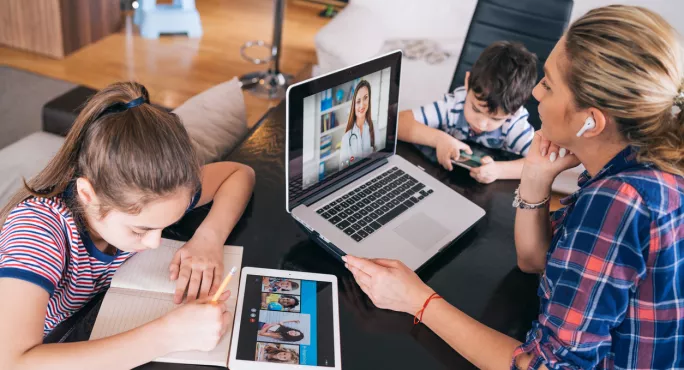
- Home
- DfE sets out best practice for remote learning
DfE sets out best practice for remote learning

As schools await the government’s forthcoming plan on easing the UK lockdown, many teachers will be wondering what the next few weeks will bring for the education sector.
But until any formal announcement is made about how and when schools will return, the focus remains on ensuring that remote learning is available to the vast majority of children - something that has proved no mean feat during the shutdown so far.
In an effort to help schools to best meet the needs of their pupils, the government has issued new advice on adapting the curriculum and adjusting teaching practices during the coronavirus shutdown, based on evidence drawn from successful case studies across the country.
Coronavirus: The school opening options that the DfE is considering
Research: Remote learning ‘rivals traditional teaching’
Spielman: It would be ‘odd’ for Ofsted to inspect online teaching
However, the Department for Education told Tes that its expectations for schools have not changed - and there is “no obligation” for teachers to adopt any of the practices outlined in the guidance.
Coronavirus: Support for remote learning
“These things aren’t being published as expectations for schools; these are just kind of examples of things that are happening around the country that we are highlighting,” a spokesperson said.
“It’s not anything to do with expecting schools to introduce these things.
“It’s not going to be used for any sort of accountability purposes, nor expectations.”
The DfE guidance states that there is “no single right answer” when it comes to remote teaching, as the exact approaches adopted by each school will vary “depending on the needs of its pupils and school context”.
But it says the following considerations “may help in adapting practices to best meet the needs of pupils”.
In terms of adjusting the curriculum, the DfE acknowledges that “teaching remotely will not be the same as education in a classroom”.
However, it says schools have found that “the essential principles of good curriculum design apply to remote education as well as classroom teaching”.
The DfE’s tips for remote learning, based on what has worked for schools, include:
- Take a pragmatic approach to covering the curriculum, prioritising important concepts and particular groups of pupils where necessary. Teachers might decide to postpone particularly tricky concepts until a later stage, although the flexibility to alter the sequence will depend on the nature of the subject.
- Take a phased approach to curriculum content when familiarising teachers and pupils with new ways of working. Some schools are postponing the introduction of new curriculum content until remote education practices are better embedded. They’re spending the first few weeks reinforcing long-term memory by consolidating topics and concepts already taught. But many schools are finding that consolidation does not have to mean repeating old lessons.
- Create educational resources in a range of formats so that they are accessible to all, reducing the risk of pupils being left behind. Pupils are more likely to have access to mobile phones than laptops or computers, so using formats (like PDFs) that can be viewed on mobile devices can improve access to resources. Other schools have identified teaching resources that can be easily printed and posted.
- Ensure remote learning practices are inclusive by researching accessibility features when planning and designing lessons. Many educational platforms that are commonly used include a wide range of free accessibility features. For example, voice-to-text and text-to-speech conversion or different viewing formats to support pupils with dyslexia and other special educational needs.
- Identify any teachers and pupils who may need additional help in making the best use of technology and tools, and think about how to address gaps in their capability and increase their confidence. Not all teachers, parents and pupils will feel confident using technology to support remote education. Some schools have provided training or peer-to-peer support to teachers and pupils.
- Provide pupils with different ways of explaining concepts or identify any likely misconceptions in advance. Teachers will have a good understanding of what effective teaching practice looks like in a classroom setting, but these same practices will often be more difficult to maintain when teaching remotely.
- Build formative assessment and feedback into teaching approaches through a mixture of quizzes, digital tools and modelling of good answers. These will help teachers to understand how pupils are achieving.
- Allow a variety of remote education practices across your school. In primary schools, for example, pupils will need more support from parents, and extended periods of screen time for learning may not be engaging without a mix of other activities. In secondary schools, older students may be able to learn more independently, while younger year groups will continue to need support. The approach to teaching and the level of contact that teachers have with pupils may also need to be different across subject areas.
The DfE adds that the schools informing the guidance have been developing their practices in “a variety of different circumstances”.
However, it says most of the examples given are from schools that “already had some infrastructure or technology in place”.
“Many schools and households do not have the same level of access,” the guidance states.
“We are developing examples of effective practice from schools in these circumstances, and for schools providing education to younger children.”
Register with Tes and you can read five free articles every month, plus you'll have access to our range of award-winning newsletters.
Keep reading for just £4.90 per month
You've reached your limit of free articles this month. Subscribe for £4.90 per month for three months and get:
- Unlimited access to all Tes magazine content
- Exclusive subscriber-only stories
- Award-winning email newsletters
You've reached your limit of free articles this month. Subscribe for £4.90 per month for three months and get:
- Unlimited access to all Tes magazine content
- Exclusive subscriber-only stories
- Award-winning email newsletters



